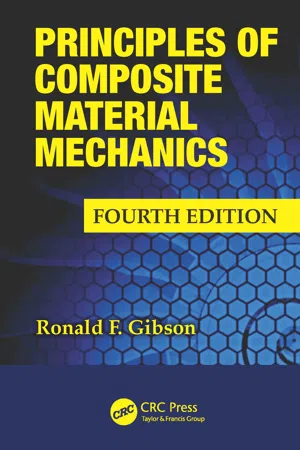
- 700 pages
- English
- ePUB (mobile friendly)
- Available on iOS & Android
eBook - ePub
Principles of Composite Material Mechanics
About this book
Principles of Composite Material Mechanics covers a unique blend of classical and contemporary mechanics of composites technologies. It presents analytical approaches ranging from the elementary mechanics of materials to more advanced elasticity and finite element numerical methods, discusses novel materials such as nanocomposites and hybrid multis
Frequently asked questions
Yes, you can cancel anytime from the Subscription tab in your account settings on the Perlego website. Your subscription will stay active until the end of your current billing period. Learn how to cancel your subscription.
At the moment all of our mobile-responsive ePub books are available to download via the app. Most of our PDFs are also available to download and we're working on making the final remaining ones downloadable now. Learn more here.
Perlego offers two plans: Essential and Complete
- Essential is ideal for learners and professionals who enjoy exploring a wide range of subjects. Access the Essential Library with 800,000+ trusted titles and best-sellers across business, personal growth, and the humanities. Includes unlimited reading time and Standard Read Aloud voice.
- Complete: Perfect for advanced learners and researchers needing full, unrestricted access. Unlock 1.4M+ books across hundreds of subjects, including academic and specialized titles. The Complete Plan also includes advanced features like Premium Read Aloud and Research Assistant.
We are an online textbook subscription service, where you can get access to an entire online library for less than the price of a single book per month. With over 1 million books across 1000+ topics, we’ve got you covered! Learn more here.
Look out for the read-aloud symbol on your next book to see if you can listen to it. The read-aloud tool reads text aloud for you, highlighting the text as it is being read. You can pause it, speed it up and slow it down. Learn more here.
Yes! You can use the Perlego app on both iOS or Android devices to read anytime, anywhere — even offline. Perfect for commutes or when you’re on the go.
Please note we cannot support devices running on iOS 13 and Android 7 or earlier. Learn more about using the app.
Please note we cannot support devices running on iOS 13 and Android 7 or earlier. Learn more about using the app.
Yes, you can access Principles of Composite Material Mechanics by Ronald F. Gibson in PDF and/or ePUB format, as well as other popular books in Physical Sciences & Materials Science. We have over one million books available in our catalogue for you to explore.
Information
Chapter 1
Introduction
1.1 Basic Concepts
Structural materials can be divided into four basic categories: metals, polymers, ceramics, and composites. Composites, which consist of two or more separate materials combined in a structural unit, are typically made from various combinations of the other three materials. In the early days of modern man-made composite materials, the constituents were typically macroscopic. As composites technology advanced over the last few decades, the constituent materials, particularly the reinforcement materials, steadily decreased in size. Most recently, there has been considerable interest in “nanocomposites” having nanometer-sized reinforcements such as carbon nanoparticles, nanofibers, and nanotubes, because of the extraordinary properties of these materials.
The relative importance of the four basic materials in a historical context has been presented by Ashby [1], as shown schematically in Figure 1.1 that clearly shows the steadily increasing importance of polymers, composites, and ceramics, and the decreasing role of metals. Composites are generally used because they have desirable properties that cannot be achieved by any of the constituent materials acting alone. The most common example is the fibrous composite consisting of reinforcing fibers embedded in a binder or matrix material. Particle or flake reinforcements are also used, but they are generally not as effective as fibers.
Figure 1.1

Relative importance of metals, polymers, composites, and ceramics as a function of time. The diagram is schematic and describes neither tonnage nor value. The timescale is nonlinear. (From Ashby, M. F. 1987. Technology of the 1990s: Advanced materials and predictive design. Philosophical Transactions of the Royal Society of London , A322, 393–407. Reproduced by pe...
Table of contents
- Preface to the First Edition
- Preface to the Second Edition
- Preface to the Third Edition
- Preface to This Edition
- Author
- Chapter 1: Introduction
- Chapter 2: Lamina Stress–Strain Relationships
- Chapter 3: Effective Moduli of a Continuous Fiber-Reinforced Lamina
- Chapter 4: Strength of a Continuous Fiber-Reinforced Lamina
- Chapter 5: Analysis of Lamina Hygrothermal Behavior
- Chapter 6: Analysis of a Discontinuously Reinforced Lamina
- Chapter 7: Analysis of Laminates
- Chapter 8: Analysis of Viscoelastic and Dynamic Behavior
- Chapter 9: Analysis of Fracture
- Chapter 10: Mechanical Testing of Composites and Their Constituents
- Chapter 11: Answers to Selected Problems
- Appendix A: Matrix Concepts and Operations
- Appendix B: Stress Equilibrium Equations
- Appendix C: Strain–Displacement Equations